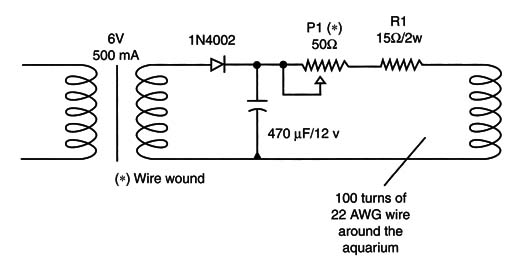Starting from the basic experiments, where we only gave the reader the elements for picking up and hearing the signals produced by the fish, we can suggest many other experiments using the signals.
In fact, bionics means the integration of living beings with electronic devices or using technology that adopts solutions provided by nature after millions of years of evolution. In the next section, we will give the reader some ideas for new projects.
Observing the Signals in an Oscilloscope
If you have an oscilloscope, you can directly observe the signals generated by the Black Ghost. It only requires plugging the electrodes to the input of the instrument and adjusting the amplitude and frequency to the appropriate value of the signals.
Figure 1 shows how to make the connections.
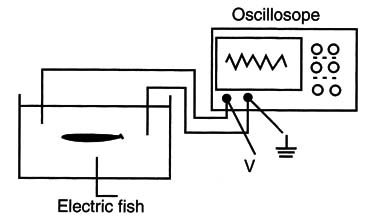
The signals can change in shape and frequency according to the specimen.
Figure 2 shows some patterns observed in these fish. If your oscilloscope has a frequency meter, you can determine the exact frequency of the signal produced by your fish.

Using the Computer and Microcontrollers
If you have a program in your computer for observing audio signals, you can use it to monitor your electric fish. It is enough to run the program and plug the electrodes into the microphone input, as shown in figure 3.
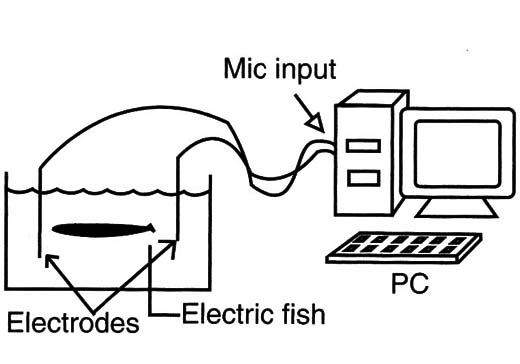
It is important to keep the wires as short as possible and not have any electric device powered from the AC power line near the aquarium, including the fluorescent lamp.
In some cases, if the amplifier used to convert the signals from the mic input to the digital form is not sensitive enough, the reader will have to use a preamplifier or even the amplifier with the LM386, picking up the signals from its output, as shown in Figure 4.
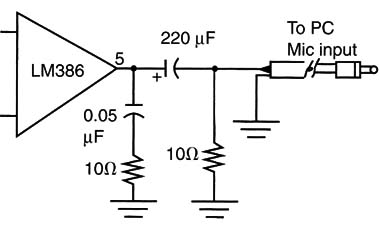
The loudspeaker can be replaced by a 10-Ω 1/2-watt resistor to act as a load to the signals if you don’t want to hear them during the experiments.
You also can plugue the electrodes to the iput of analog inputs of a microcontroller as the Arduino, MSP430 or PIC.
The signal can be processed to control displays, LEDs and even a step motor in a electric fish as the one described later in this article.
Youonly have to determine the frequency of the signal and divide by the same number to get 1 second pulse to synchronize the clock.
Using a Common Audio Amplifier
If you have an audio amplifier with a microphone input, you can use it to pick up the signals. All you have to do is plug the electrodes into the input using wires that are as short as possible. It is again recommended that no other device be plugged into the AC power line near or in the aquarium.
Driving External Circuits:
a) LED Blinker
A very interesting experiment is one that can result in practical bionic devices using the Black Ghost. The basic idea is to determine the frequency of the signal generated by the fish and divide this frequency by the some integer number, obtaining a 1 Hz signal (1 pulse per second).
This stable signal, generated by the fish, can drive electronic devices such as clocks, chronometers, and digital instruments. The simplest application is shown in Figure 5.
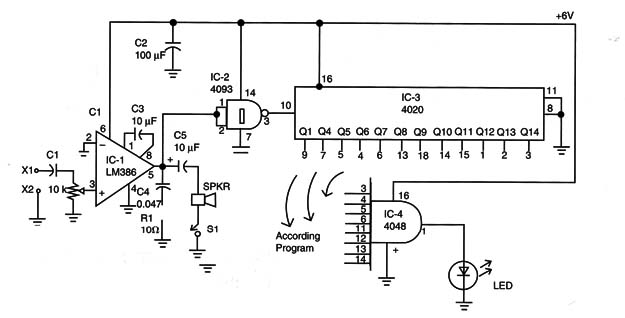
The exact frequency of the signal generated by the fish can be measured with a frequency meter or oscilloscope. For the frequency meter, it may be necessary to use an amplifier, as shown by Figure 6.
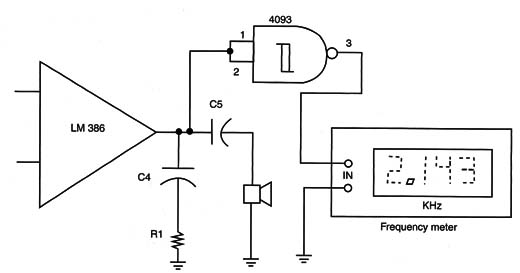
The basic amplifier using the LM386 is the ideal circuit for driving a 4093 IC, which produces a square wave from the waveshape of the signal produced by the fish.
This circuit can be used with microcontrollers with no analog iputs, using the digital input. The 4093 IC must be powered from a 5-V supply in this case.
To divide the frequency by any number, we used a 4020 complementary metal oxide semiconductor (CMOS) IC and a 4048 CMos IC.
As Figure 7 shows, the 4020 consists of a 14-stage ripple carry binary counter having 12 outputs that are a division of power-of-2 numbers of the input frequency. This means that the circuit can be used to divide the input frequency for numbers up to 16,384 (214).

Since the frequency range of the signals produced by the Black Ghost is lower than the limit reached by the 4020, it is easy to find the necessary number to have a 1 Hz signal or even other frequencies such as 0.5 Hz, 0.2 Hz, or even 0.1 Hz (one pulse at each 2, 5, and 10 seconds).
Let’s see how we can do that. Observing the 4020, we can see that the outputs are QI, Q3, Q4, Q6, and so on. They correspond to the number represented by a power of 2, by which the frequency of the input is divided. For instance, Q4 is 16 (24), so the signal in this output is the input frequency divided by 16.
The circuit doesn’t have outputs corresponding to 4 (22) and 32 (25), but the remaining outputs are enough to be combined and allow the designer to find the necessary number to establish 1 Hz with satisfactory accuracy.
Taking a numeric example, let’s imagine that our fish generates a 1,556 Hz signal. Taking this number and making the decomposition in powers of 2, we will have the following table.
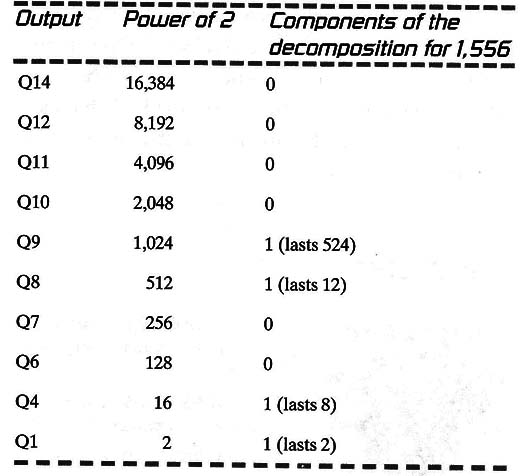
Because the 4020 does not have all the powers of 2 for outputs, the number obtained is the sum of the 1’s of the last column, or
1,024 + 512 + 16 + 2 = 1,554 Hz
This result has an accuracy better than 0.2 percent, which is enough for experimental purposes. But to get the 1 Hz signal, we must combine the corresponding outputs in a logic circuit, which is the 4048 programmed as an AND gate, as shown by figure 8.
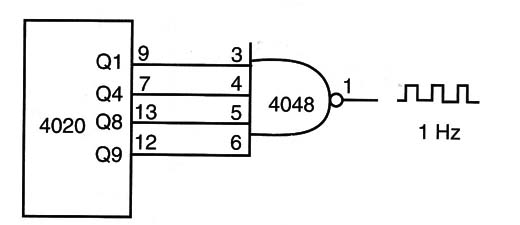
The outputs Q1, Q4, Q8, and Q9 must be con- nected to the AND gate 4048. In this configuration, by applying the signal of the outputs determined by the decomposition table to each of the 1,546 pulses at the input of the 4020, we will have one pulse at the output of the 4048. An LED connected to this output will blink at a 1 Hz frequency (one pulse per second), as desired.
Of course, the number of outputs that will be connected to the input of the 4048 will depend on the value of the input frequency. If you are lucky enough, your fish can produce a frequency corresponding to a power of 2 (1,028 Hz, for instance), so you Will not need the 4048 and can plug the LED directly to Q8, keeping the 1k ohm resistor in series, of course.
The complete circuit that makes the LED blink at a frequency near 1 Hz is shown in Figure 9, using only one output of the 4020.

Make sure one gate of the 4093 is used to drive a piezoelectric transducer, producing beeps at twice the rate at which the LED blinks.
Since the loudspeaker is not in use, it is replaced by a 100-ohm resistor, acting as a load for the amplifier. Of course, if another output is used, the beeps can be produced at half the rate of the LED blinks.
IC-1: LM386 integrated circuit, audio amplifier
IC-2: 4093 CMOS integrated circuit
IC-3: 4020 CMOS integrated circuit
LED: Common LED, any color
C1: 100 µF x 12 V electrolytic capacitor
C2: 10 µF x 12 V electrolytic capacitor
C3: 220 µF x 12 V electrolytic capacitor
C4: 0.05 or 0.047 µF ceramic or polyester capacitor
P1: 10 k ohm log or lin potentiometer
R1: 10 ohm x 1/8 W resistor, brown, black, black
R2: 100 ohm 1/8 W resistor, brown, black, brown
R3: 1 k ohm,x 1/8 W resistor, brown, black, red
S1: SPST on/off switch
B1: Four 6 V AA cells and holder
X1, X2: Metal electrodes (see text)
Other: Solderless board or PCB, wires, solder, plastic box, knob for P1, etc.
b) Clock Driven by the Electric Fish
A practical application for the signals generated by the fish is a clock. You can mount a digital clock or, if you prefer, use a cheap mechanical clock that is powered by an internal crystal that the fish’s signal will replace. This internal crystal generates 1 Hz to power the small motor, and the clock’s indicator
advances 1 second at a time from each pulse produced by the circuit. All the reader has to do is disable the crystal and apply the 1 Hz signal produced by the fish to the motor.
Another possibility is to mount an experimental clock using a gearbox with a small electric motor Figure 10 shows the circuit that will drive the motor from 1 Hz pulses produced by the fish and the circuit for an experimental clock.
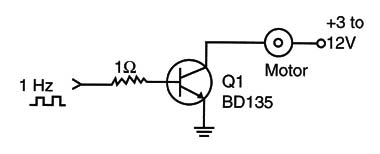
All you have to do is determine how much the indicator advances at each pulse and make a scale for the clock. You can adjust the clock to a complete turn at each minute. For instance, you can add a gear to drive an hour indicator, as shown in Figure 11. The ratio between the gears must be 1:24 or 1:12, so the second indicator will show the hours.
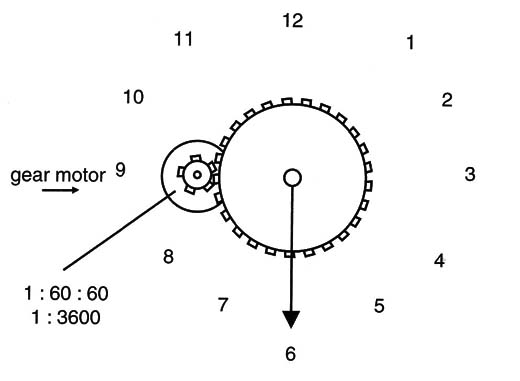
The second alternative uses a digital clock. Figure 12 shows a typical circuit of a common digital counter using the 4511 and 4518 CMOS IC driven
by the 1 Hz pulses generated by the fish.

See that this circuit counts up to 99. It must be programmed to divide by 60, with another two-digit block that must be programmed to divide by 60, giving the minutes, and a final two-digit block dividing by 12 to give the hours. Thus, you can receive the 1 Hz signal from the fish and have a 12-hour clock.
As third option you can use a microcontroller such as the Arduino to divide and display the hours, minutes and even seconds from the pulses produced by the fish.
c) The Fish as a WireIess Sensor
Today the most advanced devices in computing, communications, and even home appliances are wireless.
These devices communicate data and “talk” with one another using high-frequency radio waves, as recommended by the 802.11 standards.
Even in a variety of industries, sensors that are plugged into machines with the aim of controlling processes are now becoming wireless. The physical aspects (temperature, pressure, force, and so on) are converted to digital signals and sent to a remote receiver where they are processed, as shown by Figure 13.
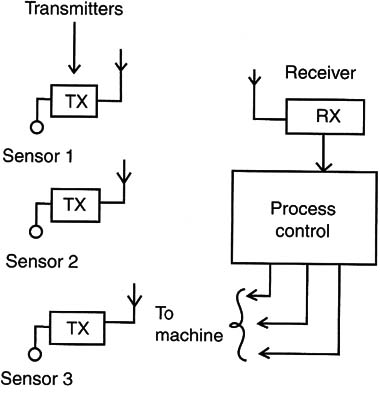
But what can nature and the electric fish teach us about communicating data without the need for cables or other physical media? The Black Ghost is a very sensitive creature. Small changes in the pH of the water, the temperature, and the presence of pollution alter the frequency of the signal generated by the fish, who can be used as a remote sensor for these changing factors.
Fish have been used to monitor water purity, for example, and this process has been patented.
Figure 14 shows how this monitoring process can be done.
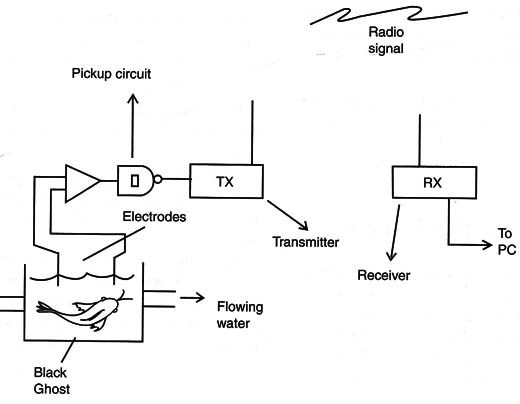
Going a little further, many creatures can detect small changes in the stress of tectonic plates. Their sense of danger can motivate them to leave a certain area before earthquakes or even tsunamis occur. It would be an interesting discovery if the Black Ghost could be used to detect such events. A simple circuit for detecting frequency changes in the fish’s signal is shown in Figure 15.
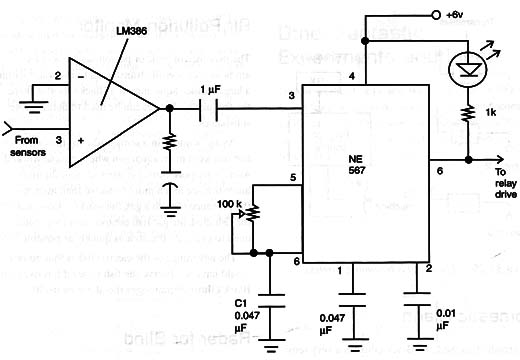
The circuit is adjusted by P1 to tune the central frequency of the signal generated by the fish. When tuned, the transistor Q1 will not conduct, and a relay is then opened. P2 is used to adjust the sensitivity of the circuit and then the bandpass.
If the frequency changes, the output of the NE567 goes to the HI logic level and the transistor Q1 starts to conduct, closing the relay. An external circuit as an alarm can be activated at this moment.
d) More Experiments and Ideas
Of course, the strange way the Itui Cavalo or Black Ghost “sees in the dark” using low-frequency current fields can be used in many new bionic devices.
What can be done depends only on the imagination of the reader. Some ideas are given here.
Domestic Alarm
As already discussed, the Black Ghost is a very sensi tive creature. The presence of noise or light changes the fish,s signal frequency. Placed in an aquarium with sensors plugged into an alarm, the fish can trigger it With the presence of intruders.
Air Pollutiion Monitor
The presence of toxic or poisonous gases in an ambient area is easily transferred to the water within a large surface aquarium. If a Black Ghost is there, the frequency changes can be used to detect those substances.
As an example, in a semiconductor factory, a pet fish was kept in an aquarium where people worked with a very poisonous gas derived from fluorine.
Since fish are much more sensitive than humans to the presence of such a gas, the workers knew that if the fish died, the gas had escaped and they would need to evacuate the area as quickly as possible.
The advantage of the electric fish is that no one would have to observe the fish to see if it is okay. The Black Ghost could trigger the alarm by itself!
Radar for Blind
Based on the fish’s system of “electric vision,” the reader can create a system based on magnetic fields or sound fields to help blind people move around the objects in a home.
You can use microcontrollers as the Arduino, PIC or MSP430 to process signals from sensors.
Very sensitive Hall Effect sensor can be used in this circuit or other types acocording the field to be detected.
Beacons can by installed in a home do help the blind to find the correct way to any place.
External Influences Research
The extreme sensitivity of the Black Ghost as a sen sor can be used to detect how external influences can affect its life. For instance, the use of light sources of different colors can be used to see how the fish alters its circadian rhythm.
Placing a coil in the aquarium and connecting it to low- or high-frequency circuits, the reader can study how magnetic fields alter the fish’s behavior. A circuit for this task is shown in Figure 16.
